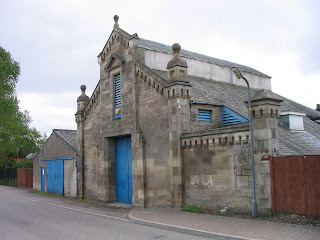An interesting building on Inverneuk is a low-relief version of this warehouse at Tain:

I took this photo while passing through on a (road) trip up North in June 2008. A couple of older views may be found at http://rniescottishailwayrchive.fotopic.net/p25206879.html. In particular, I have included the hoist on the front of the building that is no longer present, and have omitted the burglar alarm.
I began by preparing an approximate scale drawing (on the computer, based on the photos). This was printed out and mounted on cardboard as a mock-up, as featured in this shot of the embryonic scenery:

Construction of the basic superstructure was in styrene sheet. The stonework was laboriously embossed in cartridge paper which was then glued over the plastic shell. The ornamental tops to the walls, including the round finials, were scuplted from Milliput. The triangular sections were formed by running along a plastic scraper with a cut-out of the desired cross-section, although this required just the right "wetness" of the Milliput. The hoist was knocked up from scrap brass strip and bullhead rail.

Unfortunately this building (like the goods shed) is too tall to fit in the box file, so I made the upper section removable:

Here is the finished building in place, painted in acrylics. The surrounding scenery still needs development.


















